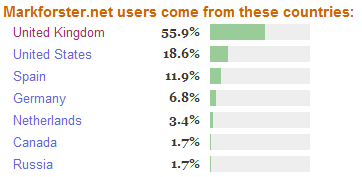The Random Element - How to get out of the rut!
 Monday, March 5, 2007 at 7:33
Monday, March 5, 2007 at 7:33 One of the things which often holds us back from making decisions is the belief that we must make the “right” decision. Sometimes people will put off making necessary decisions for years, possibly even for a lifetime, because they are afraid that they might be making the “wrong” decision. But the truth is that there is are no right and no wrong decisions, only decisions with different consequences. One way to help free up our minds’ decision making processes is to make some decisions entirely at random.
Some time ago I was coming back from giving a morning seminar in Stafford . I was driving on the motorway and, as I was in no particular hurry, I decided that I would forgo the delightful experience of having lunch in a motorway service station. Since I didn’t know the area, my normal reaction would have been to turn off the motorway and go searching for somewhere nice to eat. But for some reason this time I decided to break out of my usual rut and select a place entirely at random. To do this, I quickly invented a set of rules. I would take the next turn off the motorway and then I would turn left at every road junction. I would stop at the very first place I came to which served food whatever the place was like. I would eat there and nowhere else.
So I turned off the motorway and drove for several miles down country lanes, turning left at every junction. At the very least, I thought, I’m seeing some beautiful countryside which I would never have been likely to visit any other way. I finally came to a village, which had a charming country pub, where I had an excellent meal and met some interesting people. If it hadn’t been for the rules I had set myself, I would never have found it.
The next day I was coming back from Bury St. Edmonds at the same time of day and decided to do exactly the same thing. This time I ended up in a rather less charming pub, which was full of loud people with BMWs. Even though the company wasn’t so entertaining, I still had a good meal and felt I had done something rather more interesting than stopping on the motorway itself.
They were two different eating experiences, neither of which I would have had if I had done the obvious thing and stopped at the motorway service area, Not only would I have missed the atmosphere of two very different pubs, but I would also have lost the sense of adventure which comes from having no idea what lies around the next corner.
Actually I quite often make decisions completely at random. Have you ever noticed how you tend to stick to the safe choice when you go to a restaurant? You order something because you’ve had it before, or because you know what it is, or because the person with you recommends it. While we were in Australia and New Zealand last year we ate all sorts of Asian cuisines, including Indian, Japanese, Chinese, Malaysian, Laotian, Vietnamese, Nepalese and probably a few more that I’ve forgotten. I quickly learned not to play safe, but to order random dishes just to see what they were like — even if I didn’t have the faintest idea what they were. I don’t think I even once regretted my choice, and it greatly widened my taste experiences.
Some of you may have read the cult 70s novel The Dice Man by Luke Rhinehart. I read it when it first came out. The hero of the book takes random decision making to the extreme, but his motivation is expressed in one of the opening paragraphs of the book: “Life is islands of ecstasy in an ocean of ennui, and after the age of thirty land is seldom seen. At best we wander from one much-worn sandbar to the next, soon familiar with each grain of sand we see.” By taking decisions at the throw of a dice he found a sense of adventure in his life again.
So don’t get hung up on making the “right” decision. Make a few random decisions today, and enjoy the adventure into the unknown!






